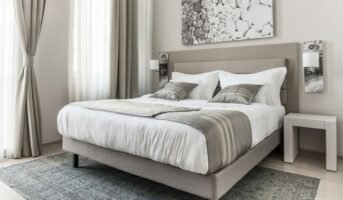For decades, Indian architecture and interior design have been enamoured by wood. It is nearly impossible to find a house that does not include any wood material in its creation! While interior design trends come and go, wooden furniture is timeless. But do you truly know what kind of wood is used in your home’s interiors? Most homeowners have limited awareness about wood products; they pay ridiculous prices for furniture.
Here is a comprehensive guide that would assist you in making an informed decision while selecting the perfect wood material for your furnishings.
Solid wood material
Using solid wood material for furniture, flooring and other applications is a costly undertaking. On the other hand, these pieces are of high quality, structurally sound and will endure a lifetime. If you have your heart set on purchasing a few gorgeous natural wood furnishings for your house, exploring second-hand marketplaces is cost-effective.

Source: Pinterest
Types of solid wood
Hardwoods and softwoods are the two primary categories of solid wood. Hardwoods are often derived from flowering trees such as mahogany, teak, oak, or walnut trees, whilst softwoods are derived from coniferous trees such as pine and deodar trees. Hardwoods grow slower and are denser than softwoods. Hardwoods have a coarser texture and a more noticeable, unmistakable natural grain, whereas softwoods have a smoother texture and a lighter grain.
Pros of solid wood material
- Solid wood furniture is highly suggested since it can be readily polished or repaired and last a lifetime.
- Solid wood material does not release harmful fumes and has a high resale value.
- The distinct grains and knots in solid wood give it a one-of-a-kind look that is irreplicable.
Cons of solid wood material
- It costs more than engineered wood.
- As hardwoods are denser, they might be difficult to cut.
- While many types of solid woods are resistant to moisture and weather, there is still a risk of exposure to the elements.
Engineered wood material
A derivative wood product, engineered /manufactured wood, is produced by binding or attaching the strands, particles, fibres, and other wood components with adhesives or other means to make a composite material. The many engineered wood products are mentioned here, along with their features and applications.
Plywood wood material
Plywood is a form of wood material created by cross-laminating thin sheets of wood veneers and bonding them with moisture-resistant adhesives under heat and pressure.

Source: Pinterest
Pros of Plywood
- Plywood does not readily bend, warp, or split since it is resistant to weather conditions.
- Plywood is also strong enough to retain screws and nails and is flexible enough to bend for curved surfaces.
Cons of Plywood
- Some kinds are created with formaldehyde-containing chemicals, which might be hazardous.
- The final product must be coated with veneers, laminates, or paints, adding to the expense.
Uses
Available in various thicknesses, the durable material may be used for a wide range of applications, including furniture, doors, wall and ceiling panels, floors, closets, handrails, and kitchen accessories. Choose BWR (boiling water resistant) or Marine plywood for outdoor projects and use in wet areas such as bathrooms. These kinds are water-resistant and insect-resistant since they are manufactured with no gaps or hollows.
MDF or medium density fibreboard wood material
MDF boards are made by combining wood fibres, wax and a resin binder and then producing panels under high temperature and pressure.

Source: Pinterest
Pros of MDF
- It is a relatively affordable choice and is simple to deal with since it allows drilling and cutting.
- It can also be treated to make it termite resistant.
Cons of MDF
- MDF sags without the support and is not suitable for building shelves or surfaces that will bear heavy loads.It is not suitable for moist locations such as the outdoors or bathrooms since it absorbs water over time.
- Harsh use can cause components such as hinges to fall out.
- MDF boards are made with chemicals including VOCs (volatile organic compounds), which can generate toxic vapours when cut and sanded.
Uses
Typical applications of MDF include producing furniture like closets, beds, and desks that are finished with a veneer, paint, or laminate. It is an excellent choice for intricately designed ornamental panels and partitions, as well as ceiling and wall claddings.
Particle Board wood material
Particle board is similar to MDF. It is made from wood chips, sawdust, and synthetic resin that is glued together and pressed into sheets.

Source: Pinterest
Pros of Particle board
- This wood material is cost-effective.
- Particle board may be made water and pest resistant with the right treatments.
Cons of Particle board
- It is not as durable as MDF and should not be used for heavy-duty items.
- It absorbs moisture and is unable to retain screws securely.
- It also produces formaldehyde and sags with time if not supported.
Uses
Particle board wood’s primary applications include countertops with a solid structural framework, an underlying layer for cabinet doors, and decorative elements like window and door trims and ceiling mouldings.
Housing News Desk is the news desk of leading online real estate portal, Housing.com. Housing News Desk focuses on a variety of topics such as real estate laws, taxes, current news, property trends, home loans, rentals, décor, green homes, home improvement, etc. The main objective of the news desk, is to cover the real estate sector from the perspective of providing information that is useful to the end-user.
Facebook: https://www.facebook.com/housing.com/
Twitter: https://twitter.com/Housing
Email: [email protected]











